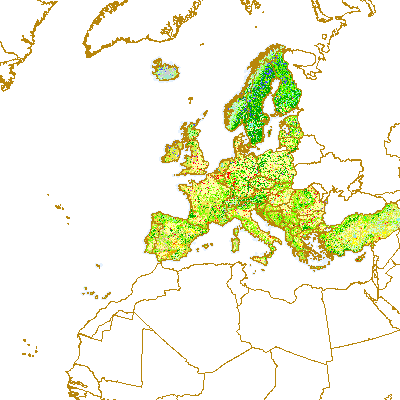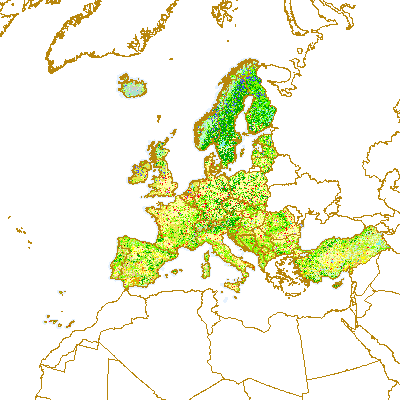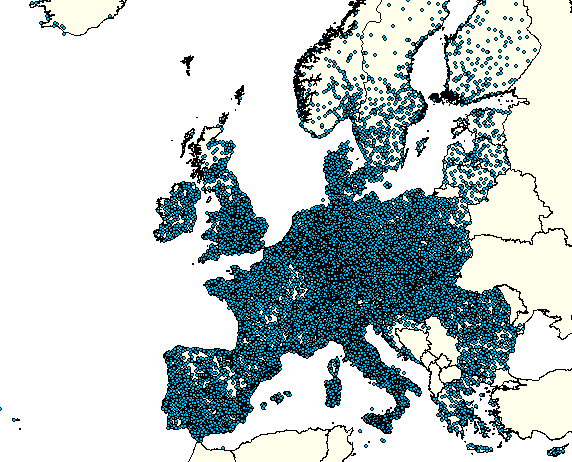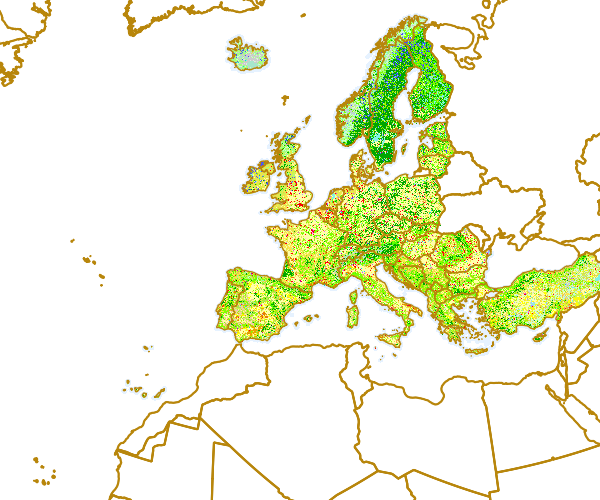biannually
Type of resources
Available actions
Topics
INSPIRE themes
Keywords
Contact for the resource
Provided by
Years
Formats
Representation types
Update frequencies
status
Scale
Resolution
-

CLC00 is one of the datasets produced within the frame the Corine Land Cover programme referring to land cover / land use status of year 2000. The Corine Land Cover (CLC) is an European programme, coordinated by the European Environment Agency (EEA), providing consistent information on land cover and land cover changes across Europe. CLC products are based on the photointerpretation of satellite images by the national teams of the participating countries - the EEA member or cooperating countries. The resulting national land cover inventories are further integrated into a seamless land cover map of Europe. The resulting European database is based on standard methodology and nomenclature with following base parameters: - 44 classes in the hierarchical 3-level Corine nomenclature - minimum mapping unit (MMU) for status layers is 25 hectares - minimum width of linear elements is 100 metres - minimum mapping unit (MMU) for Land Cover Changes (LCC) for change layers is 5 hectares CLC programme provides important data sets supporting the implementation of key priority areas of the Environment Action Programmes of the European Community as protecting ecosystems, halting the loss of biological diversity, tracking the impacts of climate change, assessing developments in agriculture and implementing the EU Water Framework Directive etc.. CLC programme is also a part of the Global Monitoring for Environment and Security (GMES http://gmes.info) initiative, run by the European Commission and the European Space Agency, which will provide environmental information from a combination of air- and space-based observation systems and in-situ monitoring. More about the Corine Land Cover (CLC) programme and datasets can be found at http://www.eea.eu.
-

With the help of CLC data it is possible to provide support for protecting ecosystems, halting the loss of biological diversity, tracking the impacts of climate change, assessing developments in agriculture and implementing the EU Water Framework Directive. CLC data is an important data set for the implementation of key priority areas of the Sixth Environment Action Programme of the European Community. CLC data can show, for instance, where fragmentation of the landscape by roads and other infrastructure is worsening and thus increasing the risk that ecosystems can no longer connect with each other, putting the survival of their flora and fauna in danger. In the agricultural field CLC data can highlight where major structural changes are continuing or intensifying, such as the conversion of pasture to arable land, expansion or reduction in the area of fallow land and land taken out of production ('set aside'), or the abandonment of farming altogether. CLC serve as input to the EC 'Inspire' (INfrastructure for SPatial InfoRmation in Europe - http://inspire.jrc.it) initiative. This initiative intends to trigger the creation of a European spatial information infrastructure that delivers to the users integrated spatial information services. CLC programme is also a contribution to the Global Monitoring for Environment and Security (GMES http://gmes.info) initiative, run by the European Commission and the European Space Agency, to provide environmental information from a combination of air- and space-based observation systems and in-situ monitoring.
-

With the help of CLC data it is possible to provide support for protecting ecosystems, halting the loss of biological diversity, tracking the impacts of climate change, assessing developments in agriculture and implementing the EU Water Framework Directive. CLC data is an important data set for the implementation of key priority areas of the Sixth Environment Action Programme of the European Community. CLC data can show, for instance, where fragmentation of the landscape by roads and other infrastructure is worsening and thus increasing the risk that ecosystems can no longer connect with each other, putting the survival of their flora and fauna in danger. In the agricultural field CLC data can highlight where major structural changes are continuing or intensifying, such as the conversion of pasture to arable land, expansion or reduction in the area of fallow land and land taken out of production ('set aside'), or the abandonment of farming altogether. CLC serve as input to the EC 'Inspire' (INfrastructure for SPatial InfoRmation in Europe - http://inspire.jrc.it) initiative. This initiative intends to trigger the creation of a European spatial information infrastructure that delivers to the users integrated spatial information services. CLC programme is also a contribution to the Global Monitoring for Environment and Security (GMES http://gmes.info) initiative, run by the European Commission and the European Space Agency, to provide environmental information from a combination of air- and space-based observation systems and in-situ monitoring.
-

With the help of CLC data it is possible to provide support for protecting ecosystems, halting the loss of biological diversity, tracking the impacts of climate change, assessing developments in agriculture and implementing the EU Water Framework Directive. CLC data is an important data set for the implementation of key priority areas of the Sixth Environment Action Programme of the European Community. CLC data can show, for instance, where fragmentation of the landscape by roads and other infrastructure is worsening and thus increasing the risk that ecosystems can no longer connect with each other, putting the survival of their flora and fauna in danger. In the agricultural field CLC data can highlight where major structural changes are continuing or intensifying, such as the conversion of pasture to arable land, expansion or reduction in the area of fallow land and land taken out of production ('set aside'), or the abandonment of farming altogether. CLC serve as input to the EC 'Inspire' (INfrastructure for SPatial InfoRmation in Europe - http://inspire.jrc.it) initiative. This initiative intends to trigger the creation of a European spatial information infrastructure that delivers to the users integrated spatial information services. CLC programme is also a contribution to the Global Monitoring for Environment and Security (GMES http://gmes.info) initiative, run by the European Commission and the European Space Agency, to provide environmental information from a combination of air- and space-based observation systems and in-situ monitoring.
-

UWWTD Discharge Points, Oct. 2019 is one of the datasets produced within the frame of the reporting under 10th UWWTD Art.15 reporting period (UWWTD data call 2017). The Urban Waste Water Treatment Directive (UWWTD) (91/271/EEC) obliges Member States to report data on the implementation of the Directive upon request from the European Commission bi-annually. Reported data include receiving areas as designated under UWWTD, agglomerations, urban waste water treatment plants serving the agglomerations and points of discharges. Dataset UWWTD_DischargePoints contains information on individual points of discharge from urban waste water treatment plants or collecting systems, including their coordinates of discharge, link to specific treatment plant, type of receiving area into which the effluent / wastewater is discharged, related waterbody (or river basin), information on the discharge on land and potential reuse of the treated waste water. The public dataset of discharge points is not used in published UWWTD maps (https://www.eea.europa.eu/themes/water/european-waters/water-use-and-environmental-pressures/uwwtd/interactive-maps/urban-waste-water-treatment-maps-2) for the time being. The source discharge points dataset is available in tabular format through the EEA website (https://www.eea.europa.eu/data-and-maps/data/waterbase-uwwtd-urban-waste-water-treatment-directive-6). The full (internal) dataset including inactive discharge points is available under "Urban Waste Water Treatment Directive, Discharge points reported under UWWTD data call 2017 - INTERNAL VERSION - Oct. 2019"
-

With the help of CLC data it is possible to provide support for protecting ecosystems, halting the loss of biological diversity, tracking the impacts of climate change, assessing developments in agriculture and implementing the EU Water Framework Directive. CLC data is an important data set for the implementation of key priority areas of the Sixth Environment Action Programme of the European Community. CLC data can show, for instance, where fragmentation of the landscape by roads and other infrastructure is worsening and thus increasing the risk that ecosystems can no longer connect with each other, putting the survival of their flora and fauna in danger. In the agricultural field CLC data can highlight where major structural changes are continuing or intensifying, such as the conversion of pasture to arable land, expansion or reduction in the area of fallow land and land taken out of production ('set aside'), or the abandonment of farming altogether. CLC serve as input to the EC 'Inspire' (INfrastructure for SPatial InfoRmation in Europe - http://inspire.jrc.it) initiative. This initiative intends to trigger the creation of a European spatial information infrastructure that delivers to the users integrated spatial information services. CLC programme is also a contribution to the Global Monitoring for Environment and Security (GMES http://gmes.info) initiative, run by the European Commission and the European Space Agency, to provide environmental information from a combination of air- and space-based observation systems and in-situ monitoring.
-

CLC06 is one of the datasets produced within the frame the Corine Land Cover programme referring to land cover / land use status of year 2006. The Corine Land Cover (CLC) is an European programme, coordinated by the European Environment Agency (EEA), providing consistent information on land cover and land cover changes across Europe. CLC products are based on the photointerpretation of satellite images by the national teams of the participating countries - the EEA member or cooperating countries. The resulting national land cover inventories are further integrated into a seamless land cover map of Europe. The resulting European database is based on standard methodology and nomenclature with following base parameters: - 44 classes in the hierarchical 3-level Corine nomenclature - minimum mapping unit (MMU) for status layers is 25 hectares - minimum width of linear elements is 100 metres - minimum mapping unit (MMU) for Land Cover Changes (LCC) for change layers is 5 hectares CLC programme provides important data sets supporting the implementation of key priority areas of the Environment Action Programmes of the European Community as protecting ecosystems, halting the loss of biological diversity, tracking the impacts of climate change, assessing developments in agriculture and implementing the EU Water Framework Directive etc.. CLC programme is also a part of the Global Monitoring for Environment and Security (GMES http://gmes.info) initiative, run by the European Commission and the European Space Agency, which will provide environmental information from a combination of air- and space-based observation systems and in-situ monitoring. More about the Corine Land Cover (CLC) programme and datasets can be found at http://www.eea.europa.eu
-

CLC06 is one of the datasets produced within the frame the Corine Land Cover programme referring to land cover / land use status of year 2006. The Corine Land Cover (CLC) is an European programme, coordinated by the European Environment Agency (EEA), providing consistent information on land cover and land cover changes across Europe. CLC products are based on the photointerpretation of satellite images by the national teams of the participating countries - the EEA member or cooperating countries. The resulting national land cover inventories are further integrated into a seamless land cover map of Europe. The resulting European database is based on standard methodology and nomenclature with following base parameters: - 44 classes in the hierarchical 3-level Corine nomenclature - minimum mapping unit (MMU) for status layers is 25 hectares - minimum width of linear elements is 100 metres - minimum mapping unit (MMU) for Land Cover Changes (LCC) for change layers is 5 hectares CLC programme provides important data sets supporting the implementation of key priority areas of the Environment Action Programmes of the European Community as protecting ecosystems, halting the loss of biological diversity, tracking the impacts of climate change, assessing developments in agriculture and implementing the EU Water Framework Directive etc.. CLC programme is also a part of the Global Monitoring for Environment and Security (GMES http://gmes.info) initiative, run by the European Commission and the European Space Agency, which will provide environmental information from a combination of air- and space-based observation systems and in-situ monitoring. More about the Corine Land Cover (CLC) programme and datasets can be found at http://www.eea.eu.
-

UWWTD Discharge Points, Nov. 2017 is one of the datasets produced within the frame of the reporting under 9th UWWTD Art.15 reporting period (UWWTD data call 2015). The Urban Waste Water Treatment Directive (UWWTD) (91/271/EEC) obliges Member States to report data on the implementation of the Directive upon request from the European Commission bi-annually. Reported data include receiving areas as designated under UWWTD, agglomerations, urban waste water treatment plants serving the agglomerations and points of discharges. Dataset UWWTD_DischargePoints contains information on individual points of discharge from urban waste water treatment plants or collecting systems, including their coordinates of discharge, link to specific treatment plant, type of receiving area into which the effluent / wastewater is discharged, related waterbody (or river basin), information on the discharge on land and potential reuse of the treated waste water. The discharge points layer is not used in UWWTD maps, therefore it is not included in any existing map service for the time being. The dataset is available only in tabular format through the EEA website.
-

CLC00 is one of the datasets produced within the frame the Corine Land Cover programme referring to land cover / land use status of year 2000. The Corine Land Cover (CLC) is an European programme, coordinated by the European Environment Agency (EEA), providing consistent information on land cover and land cover changes across Europe. CLC products are based on the photointerpretation of satellite images by the national teams of the participating countries - the EEA member or cooperating countries. The resulting national land cover inventories are further integrated into a seamless land cover map of Europe. The resulting European database is based on standard methodology and nomenclature with following base parameters: - 44 classes in the hierarchical 3-level Corine nomenclature - minimum mapping unit (MMU) for status layers is 25 hectares - minimum width of linear elements is 100 metres - minimum mapping unit (MMU) for Land Cover Changes (LCC) for change layers is 5 hectares CLC programme provides important data sets supporting the implementation of key priority areas of the Environment Action Programmes of the European Community as protecting ecosystems, halting the loss of biological diversity, tracking the impacts of climate change, assessing developments in agriculture and implementing the EU Water Framework Directive etc.. CLC programme is also a part of the Global Monitoring for Environment and Security (GMES http://gmes.info) initiative, run by the European Commission and the European Space Agency, which will provide environmental information from a combination of air- and space-based observation systems and in-situ monitoring. More about the Corine Land Cover (CLC) programme and datasets can be found at http://www.eea.europa.eu
 RUC Geo-Data catalogue
RUC Geo-Data catalogue